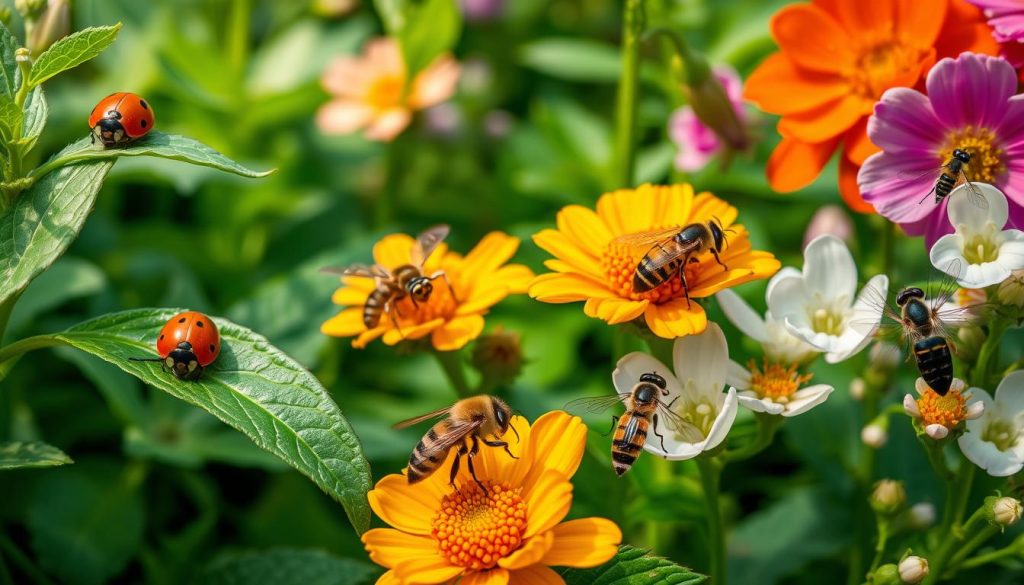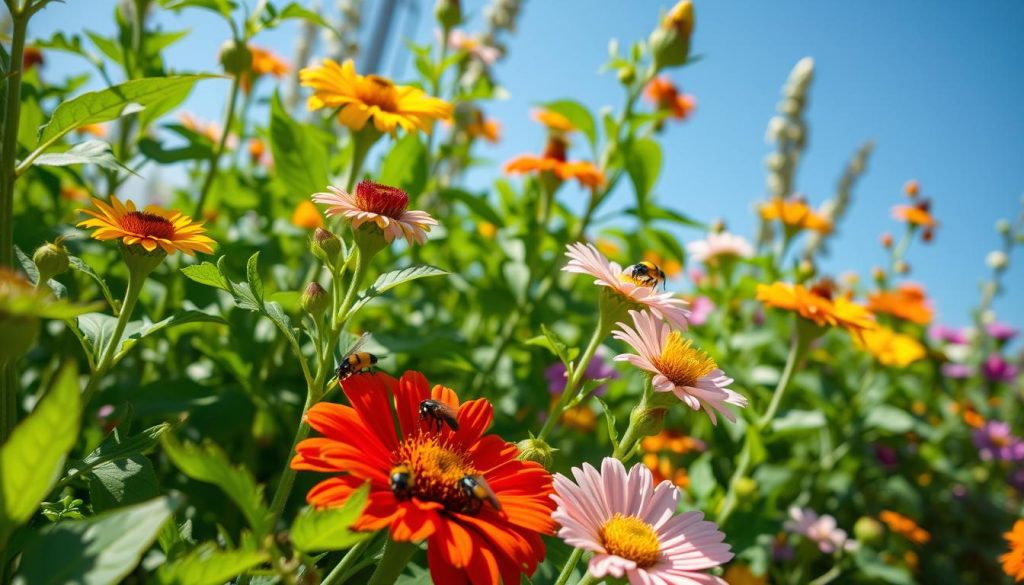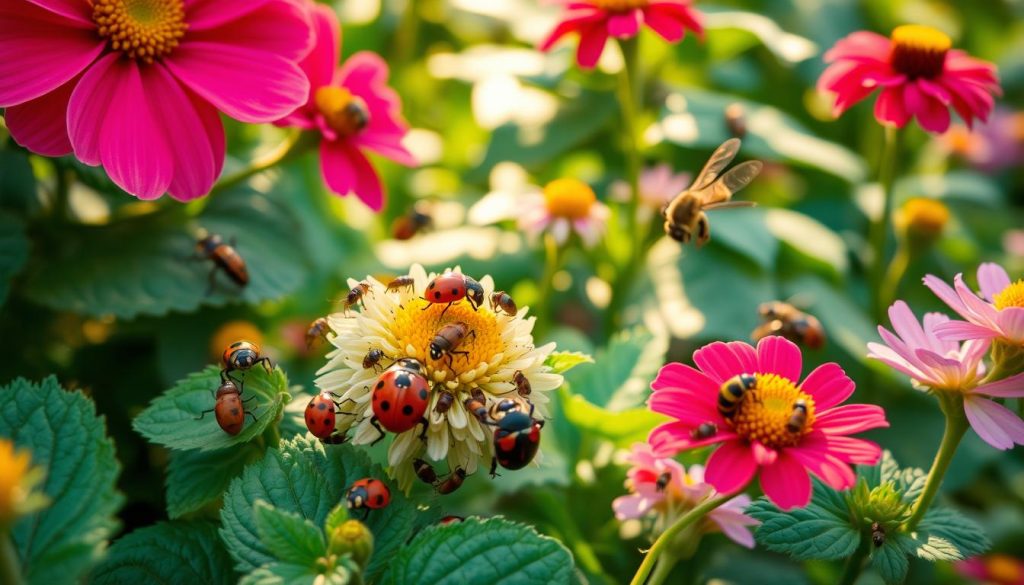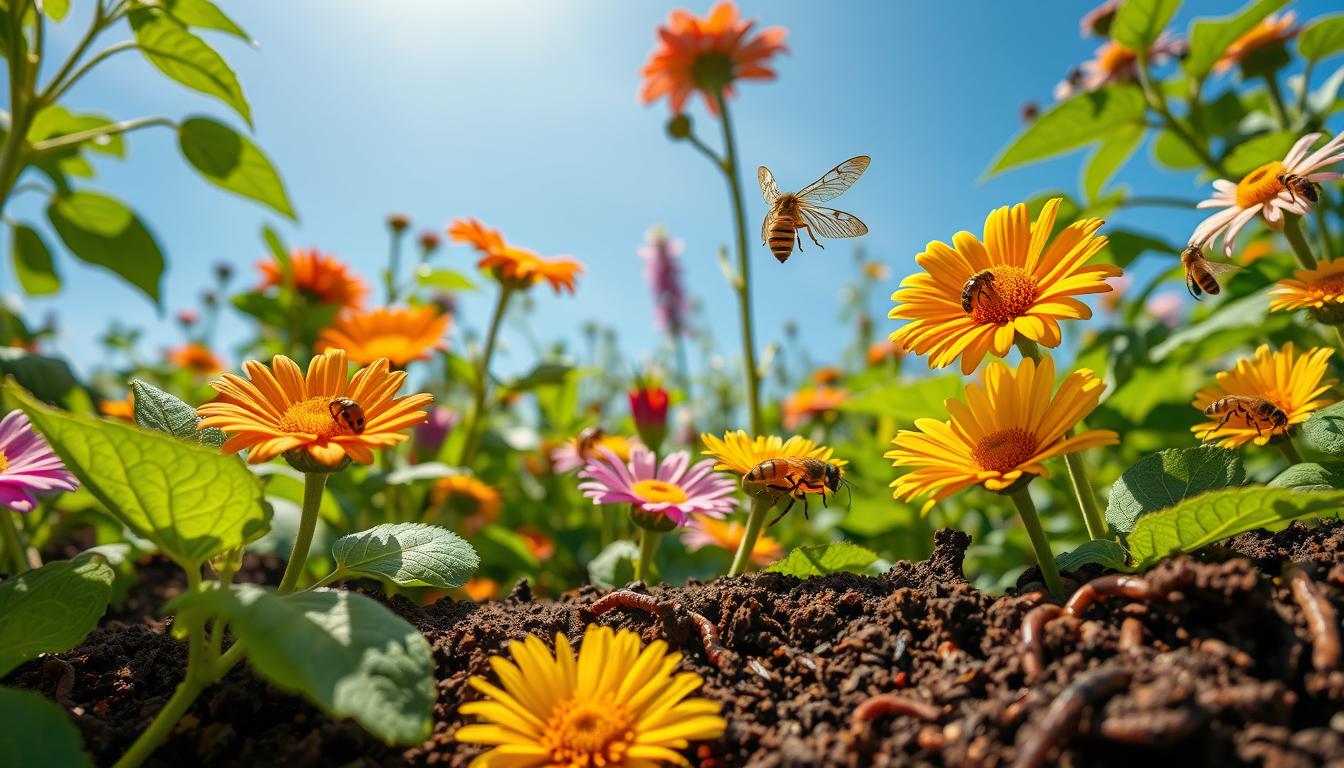As a gardener, I’ve found that beneficial insects are key to a balanced garden. They help control pests naturally. This way, I’ve cut down on chemical pesticides and made my garden healthier.
Beneficial insects have changed my garden for the better. They help control pests naturally, making my garden healthier. In this article, I’ll share my top 5 beneficial insects. I’ll also give tips on how to attract and keep them using natural methods.
Why Beneficial Insects Matter for My Garden
Exploring organic gardening with insects has shown me how important beneficial bugs are. Attracting these insects is key to a balanced garden. They help with pollination, controlling pests, and keeping plants healthy. By welcoming these insects, my garden flourishes.
Some of the key benefits of beneficial insects include:
- Pollination: Beneficial insects like bees and butterflies help transfer pollen between flowers, allowing plants to reproduce.
- Pest control: Insects like ladybugs and lacewings feed on pests that can damage plants, reducing the need for pesticides.
- Supporting plant health: Beneficial insects can help to break down organic matter, improving soil health and reducing the risk of disease.
By using organic gardening with insects, I make my garden sustainable and balanced. Attracting beneficial insects is a big part of this. I do this by planting a variety of flowers and herbs. These provide food and shelter for the insects.
Beneficial insects are essential for a healthy garden. Understanding their role helps me attract and support them. This way, I create a balanced and sustainable garden that benefits my plants and the environment.
My Favorite Beneficial Insects
I’m excited to share my favorite beneficial insects for a thriving garden. These insects are vital for a healthy garden ecosystem. Knowing their role is key for any gardener.
For a successful garden, a balanced ecosystem is crucial. Beneficial insects are essential for this balance. Some top beneficial insects include:
- Ladybugs, which are known for their aphid-controlling abilities
- Lacewings, which are expert predators of whiteflies and other pests
- Parasitic wasps, which are tiny but mighty heroes in the fight against garden pests
These insects are not only beneficial but also fascinating to watch. By creating a welcoming environment for them, I’ve seen a big drop in pests in my garden. To attract these beneficial insects, it’s important to plant a variety of flowers and herbs that provide nectar and shelter.

By adding these beneficial insects to my garden, I’ve seen a big improvement in my plants’ health and productivity. Whether you’re a seasoned gardener or just starting, I recommend exploring beneficial insects. They can greatly benefit your garden.
How to Attract Beneficial Insects
To have a healthy garden, it’s key to draw in beneficial insects. These insects help keep the garden balanced and fight pests. Knowing what they like helps gardeners make a welcoming space for them.
Creating a Pollinator-Friendly Habitat
A garden that welcomes pollinators is crucial. Planting a mix of flowers that offer nectar and pollen is a good start. Sunflowers, zinnias, and cosmos are great choices. They attract bees, butterflies, and ladybugs, among others.
Choosing the Right Plants
Picking the right plants is important. Some, like marigolds and nasturtiums, keep pests away and draw in good bugs. These plants help create a garden that needs little help from humans.
Minimizing Chemical Usage
Using fewer chemicals is vital for a garden that welcomes beneficial insects. Pesticides can harm these helpful bugs, upsetting the garden’s balance. Natural pest control methods, like introducing beneficial insects or using barriers, keep the garden healthy.
Natural Predators at Work in My Garden
As I care for my garden, I’ve learned how vital natural predators are. By using organic gardening with insects, I’ve made a safe space for beneficial bugs. It’s amazing to see how different species work together.
In my garden, ladybugs and lacewings are key in controlling pests. They help keep nature in balance. By supporting them, I’ve cut down on chemical pesticides. This method protects the environment and helps my plants grow well.
The Balance of Nature
To help natural predators, I’ve added plants that attract beneficial insects. For instance, I’ve planted marigolds for ladybugs and dill for lacewings. This diversity makes my garden a welcoming place for all.

Observing Insect Behavior
Watching insects has taught me a lot about my garden’s ecosystem. It shows me how different species interact. This knowledge helps me improve my gardening to support these beneficial insects better.
- Planting a diverse range of flowers and herbs to attract beneficial insects
- Providing shelter and food sources for natural predators
- Minimizing the use of chemical pesticides to protect beneficial insects
By using these strategies, I’ve made a garden that’s full of life. It shows the beauty of organic gardening with insects and the role of beneficial bugs for plants.
Seasonal Changes and Beneficial Insects
As the seasons change, so does the activity of beneficial insects in my garden. I adjust my gardening to keep them happy all year. This helps keep pests under control.
Beneficial insects like ladybugs and lacewings are key to a healthy garden. I plant flowers and herbs for them to eat. This makes my garden healthier and more diverse.
Insect Activity Throughout the Year
Spring brings more aphids, which ladybugs love to eat. Summer is when lacewings and wasps fight whiteflies and spider mites. Knowing this helps me garden better.
Planting for Every Season
I plant different flowers and herbs for each season. This gives beneficial insects food and shelter all year. It keeps my garden balanced and pest-free.
- Spring-blooming flowers like crocus and daffodil
- Summer-blooming flowers like marigold and zinnia
- Fall-blooming flowers like aster and chrysanthemum
Challenges I Face with Beneficial Insects
Keeping my garden healthy with beneficial insects is not easy. Pests often outnumber these helpful bugs. This imbalance can harm my plants. So, I must find natural ways to manage pests.
Understanding the environment is key to attracting beneficial insects. I study their life cycles, habitats, and how seasons affect them. By knowing which insects are best for my garden, I can attract them more easily.
Pests That Outnumber Allies
- Aphids and whiteflies can quickly overwhelm my plants if left unchecked
- Using natural pest management methods, such as introducing ladybugs or lacewings, can help control these pests
- Regular monitoring of my garden is crucial to detect any imbalances in the ecosystem

Environmental Factors to Consider
To attract beneficial insects, I need to create a welcoming environment. This means providing shelter, food, and water. I also avoid using harmful chemicals to protect these helpful bugs.
My Personal Success Stories
I’ve seen the good effects of beneficial insects in my garden. By attracting these insects, I’ve cut down on pests and boosted plant health. Ladybugs have been especially helpful in controlling pests.
Thriving Plants Thanks to Ladybugs
Ladybugs have fought off aphids, helping my plants grow strong. Lacewings have also been key in fighting whiteflies. This shows how beneficial insects can control pests.
Effective Pest Management with Lacewings
Lacewings are a big part of my pest control plan. They help me use fewer chemicals and keep my garden balanced.
Unexpected Benefits of Parasitic Wasps
Parasitic wasps have been a surprise help, controlling caterpillars and reducing disease risk. Using beneficial insects has made my garden stronger and more sustainable.
Tips for Maintaining an Insect-Friendly Garden
Creating an insect-friendly garden is a delicate task. It’s not just about attracting beneficial insects like ladybugs and lacewings. It’s also about adapting my garden practices to support these natural allies.
Regular Monitoring and Adjustments
I regularly observe my garden and watch the insect activity. This lets me spot any changes or issues early. I’m always ready to adjust my strategies to keep beneficial bugs thriving.
Educating Myself on Insect Species
Knowing about different insect species is key. I keep learning about their unique traits and roles. This knowledge helps me create the best conditions for them to thrive in my organic garden.
Sharing Knowledge with Fellow Gardeners
Sharing my experiences with other gardeners is important. I join local clubs, social media groups, and online forums. We exchange tips and celebrate our successes in attracting beneficial insects. Together, we inspire more people to garden with insects in mind.

